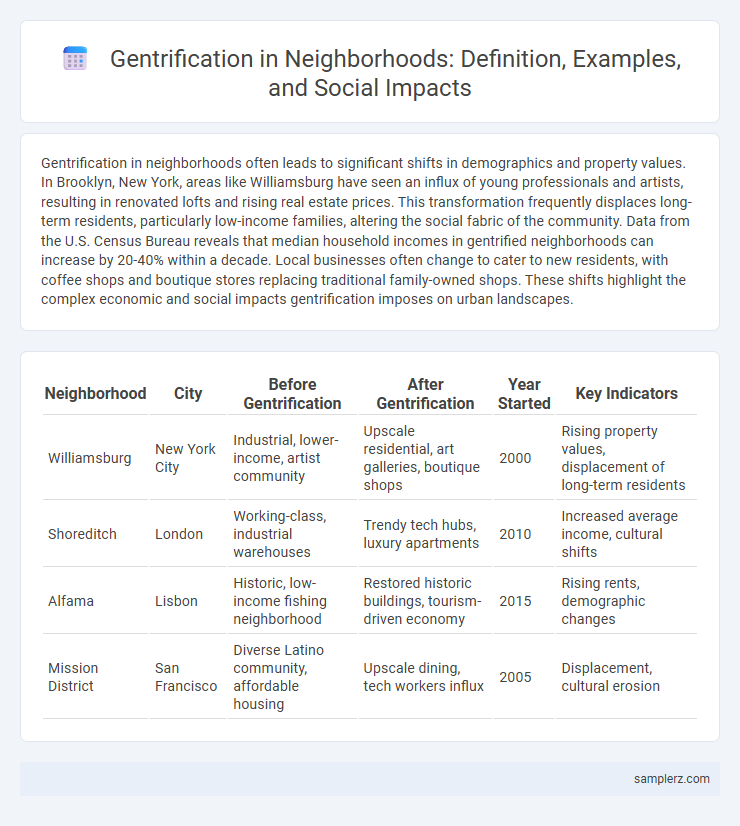Gentrification in neighborhoods often leads to significant shifts in demographics and property values. In Brooklyn, New York, areas like Williamsburg have seen an influx of young professionals and artists, resulting in renovated lofts and rising real estate prices. This transformation frequently displaces long-term residents, particularly low-income families, altering the social fabric of the community. Data from the U.S. Census Bureau reveals that median household incomes in gentrified neighborhoods can increase by 20-40% within a decade. Local businesses often change to cater to new residents, with coffee shops and boutique stores replacing traditional family-owned shops. These shifts highlight the complex economic and social impacts gentrification imposes on urban landscapes.
Table of Comparison
| Neighborhood | City | Before Gentrification | After Gentrification | Year Started | Key Indicators |
|---|---|---|---|---|---|
| Williamsburg | New York City | Industrial, lower-income, artist community | Upscale residential, art galleries, boutique shops | 2000 | Rising property values, displacement of long-term residents |
| Shoreditch | London | Working-class, industrial warehouses | Trendy tech hubs, luxury apartments | 2010 | Increased average income, cultural shifts |
| Alfama | Lisbon | Historic, low-income fishing neighborhood | Restored historic buildings, tourism-driven economy | 2015 | Rising rents, demographic changes |
| Mission District | San Francisco | Diverse Latino community, affordable housing | Upscale dining, tech workers influx | 2005 | Displacement, cultural erosion |
Introduction: Understanding Gentrification in Neighborhoods
Gentrification transforms urban neighborhoods as higher-income residents move in, driving up property values and altering the local culture. This process often displaces long-term, lower-income families, reshaping the demographic and economic landscape. Key examples include Brooklyn's Williamsburg and San Francisco's Mission District, where rapid development and rising rents have sparked community debates.
Historical Overview of Gentrification
Gentrification in neighborhoods such as Brooklyn's Williamsburg began in the late 20th century as artists and young professionals moved into formerly industrial or low-income areas, sparking significant demographic shifts. Historical trends reveal that property values and rental rates increased dramatically, displacing long-term residents and altering the cultural fabric. This process often results in economic revitalization, but raises critical social equity concerns regarding affordable housing and community preservation.
Case Study: Gentrification in Brooklyn, New York
Brooklyn, New York, exemplifies gentrification through significant demographic shifts, rising property values, and increased investment in infrastructure and amenities. Neighborhoods like Williamsburg experienced an influx of affluent residents, leading to displacement of long-standing, lower-income communities and changes in cultural identity. This transformation reflects broader trends of urban redevelopment, economic stratification, and social tension in rapidly evolving metropolitan areas.
Economic Impacts on Local Residents
Gentrification in neighborhoods such as Brooklyn's Williamsburg leads to rising property values and increased rent, often displacing long-term, lower-income residents. Economic impacts include loss of affordable housing and reduced financial stability for local families. Small businesses catering to original residents frequently struggle to survive amid escalating costs and shifting demographics.
Cultural Changes and Community Shifts
Gentrification in neighborhoods like Brooklyn's Williamsburg has led to cultural changes marked by an influx of affluent residents and upscale businesses, displacing long-standing communities. Traditional local shops and community centers are replaced by trendy cafes and boutiques, altering the neighborhood's ethnic and socioeconomic fabric. These shifts often result in diminished cultural diversity and weakened social cohesion among original residents.
Displacement and Housing Affordability Issues
The rapid gentrification of Brooklyn's Williamsburg neighborhood has led to significant displacement of long-term residents, primarily low-income families and minority communities, struggling to afford rising housing costs. As property values and rents escalate, affordable housing options have dwindled, forcing many to relocate to more distant, less desirable areas. This shift exacerbates socioeconomic divides and strains local social services in surrounding neighborhoods.
The Role of Small Businesses in Gentrifying Areas
Small businesses in gentrifying neighborhoods often serve as catalysts for economic revitalization by attracting new customers and increasing foot traffic. They provide unique cultural products and services that maintain the area's local identity while appealing to changing demographics. However, these businesses can also contribute to rising rents and displacement by signaling investment potential to larger commercial developers.
Responses and Resistance from Long-Term Residents
Long-term residents in gentrifying neighborhoods often organize tenant unions and community associations to resist displacement and advocate for affordable housing policies. Grassroots movements, such as rent strikes and public protests, challenge developers and local authorities aiming to prioritize residents' rights. These collective actions help preserve cultural identity and promote inclusive urban development.
Urban Policies Influencing Gentrification
Urban policies such as zoning changes, tax incentives, and public infrastructure investments have significantly influenced gentrification patterns in neighborhoods like Brooklyn, New York. These policies often attract higher-income residents and businesses, driving up property values and displacing long-standing communities. Research shows that inclusionary zoning and rent control measures can mitigate some negative effects, yet many areas continue to experience socio-economic shifts due to strategic urban planning.
Future Outlook: Sustainable Community Development
Gentrification in neighborhoods like Brooklyn's Williamsburg shows potential for sustainable community development by integrating affordable housing initiatives with eco-friendly urban planning. Implementing green infrastructure and preserving local culture fosters long-term social equity and environmental resilience. Future outlooks emphasize collaborative governance and inclusive policies to balance growth with community needs.

example of gentrification in neighborhood Infographic
 samplerz.com
samplerz.com